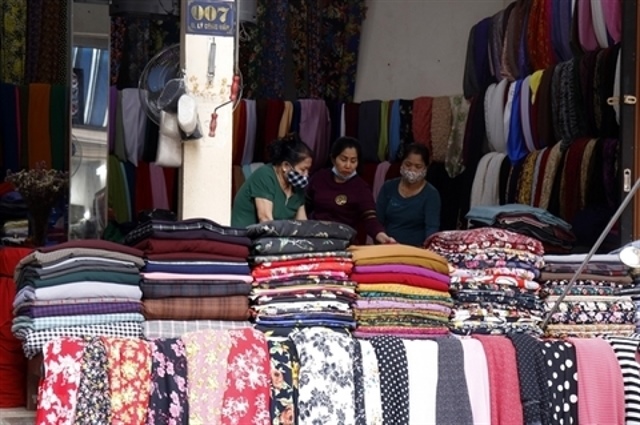Gov’t to have more fiscal, monetary maneuverability in 2012
Gov’t to have more fiscal, monetary maneuverability in 2012
Vietnamese fiscal and monetary policies will likely be more maneuverable in 2012, as the country’s macroeconomic situation is stabilizing, said an economist who is also a member of the National Assembly’s Economics Committee.
The remaining difficulties for 2012 include how the government can offer enough liquidity for the economy at an affordable rate so that it can growth steadily, said Dr. Tran Du Lich, a member of the National Advisory Council on Financial and Monetary Policy.
The money pumping must be adequate and monitored strictly so that it will not set off another round of inflation in the coming years, said Lich, director of the Ho Chi Minh City Institute for Economic Research, at a recent forum.
“Inflation in 2012 will not exceed 10 percent, and in my view, it will stand at 9 percent at most. Without future money pumping, it may be as low as around 5-6 percent for 2012”, he said at the "Macroeconomic and the Stock Market in 2012" event held by Kim Eng Vietnam Securities Co.
The main difficulty for Vietnam this year is far different from that of 2011, namely the vicious circle of high-rise inflation, which peaked at about 23 percent in August, and the devaluation of Vietnam dong.
Such economic constraints, resulting in Resolution 11, limited the maneuverability of both fiscal and financial policies in 2011.
At the start of 2011, amid the feasible return of high inflation that had already dampened business sentiments in the previous year, the State Bank of Vietnam devalued the dong by 8.5 percent in February. The government had to issue Resolution 11 – the tightening fiscal and monetary policies – to prevent the dong from falling further.
2012: brighter and better
But regarding the 2012 macroeconomic picture, as inflation is cooling down and the national foreign exchange reserve is improving due to the decreasing trade deficit, there will be no further devaluation of the dong, he said.
But the problem now is liquidity for the economy, since nearly 29 percent of businesses had ceased operations as of April 30, 2012, Lich said.
The liquidity constraint of the economy was caused by the same shortage in the banking system in 2011.
By the end of 2011, total lending with real estate collaterals at Vietnamese commercial banks accounted for 53 percent of total outstanding credit, equivalent to $70 billion.
With the amount of the mortgaged properties, this is the direct cause of the liquidity shortage of commercial banks.
"Trade deficit reduction in Q1/2012 is a positive economic indicator to many, but in my view, it is a worrisome signal. When many enterprises stopped production, they stopped importing raw materials, thus reducing the trade gap.”
“It is not a miracle caused by operational measures of the Ministry of Industry and Trade. However, the reduction in exports and imports has facilitated the stability of the Vietnamese currency," Lich said.
According to Dr. Lich, the processing industry grew by as little as 4.3 percent in the first four months of this year, but now the growth rate seems to be improving.
In terms of gross domestic product (GDP) growth, Vietnam has seen the lowest domestic product increase since 2009 in Q1/2012; with total consumption and retail value of the local market increasing by only 3.1 percent, compared to the previous rate of over 10 percent, excluding inflation.
According to the latest report from the Ministry of Planning and Investment, as of early April inventories had increased very strongly.
Specifically, the amount of unsold stocks are on a rise over the same period last year, including 63.4 percent in chemical fertilizer, 41.2 percent in cement, 38.9 percent in mopeds and motorcycles, 35.6 percent in garment-textile, 102 percent in plastic products, 101 percent in metals, and 94.8 percent in processed fruit and vegetables.
“With such a rise in inventories, nobody dares to produce more," Lich said.
As of last month, the total number of registered business enterprises was 647,600, but only about 463,800 businesses are still operational. Thus, the number of active enterprises accounted for only 71.6 percent of registered enterprises.
Among the remaining 29.4 percent, 82,000 have been dissolved, 16,000 have stopped working for tax returns, and 85,800 are left without any understanding of what real estate is theirs.
Under this situation, enterprises are classified into three types.
The first are the most healthy ones, the most wanted group for lending, but they will not borrow; while the second group, though still operational, found that more lending will bring them no profits, so they also limits their borrowings.
In this context, bad debt is very high and increasing, especially in the weak banks. So, there are good banks with surpluses, but they are doing nothing but buying government bonds at an interest rate of about 11.5 percent a year to maintain liquidity capacity.
“Therefore, I had suggested in late 2011 that the Government warm up the real estate and securities markets.”
Finding a sustainable rate for growth
If Vietnam’s GDP growth doesn’t recover by the end of the coming quarter, the national economy will probably fall into stagflation, the combination of stagnation and inflation.
If this were to happen the 6 to 6.5 percent growth target set this year by the Government will be difficult to achieve.
But if easing monetary policies by increasing the money supply is so drastic as to stimulate growth, the inflation risk will come back in 2013.
So, finding an adequate money supply for a 5.5 percent GDP growth is the most sustainable scenario, he said.
If the average interest rate of 10 percent is a real positive for depositors, Lich said the depositing interest rates will decrease gradually to 10 percent a year so that lending rate will be about 13 percent a year.
tuoitrernews



















